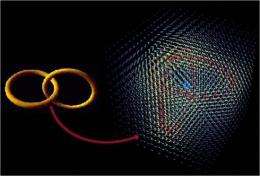Cracks in the Universe: Physicists are searching for the fingerprints of cosmic strings

Physicists are hot on the trail of one of strangest theorized structures in the universe. A team of researchers have announced what they think are the first indirect observations of ancient cosmic strings, bizarre objects thought to have contributed to the arrangement of objects throughout the universe.
First predicted back in the 1970s, cosmic strings are thought to be enormous fault lines that once existed in space. Not to be confused with the subatomic strings of string theory, cosmic strings are widely believed by astrophysicists to have formed billions of years ago, just moments after the Big Bang when the universe was still a soupy mass of extremely hot matter. As the universe cooled, defects formed between different regions of space that cooled in different ways, much like cracks forming in the ice on a frozen pond. These defects in space were the cosmic strings.
Although researchers have not yet directly observed the strings themselves, the team believes they found evidence of them hidden in ancient quasars, enormous black holes that shoot out mighty jets of light and radiation, found at the heart of many galaxies.
The presumed cosmic strings were incredibly narrow, thinner than the diameter of a proton, but so dense that a string less than a mile in length would weigh more than the Earth. As the universe expanded, so too did these strings until they either stretched across the known universe, or into enormous rings thousands of times larger than our galaxy.
"Their magnetic field sort of hitches a ride with the expansion of the universe," said Robert Poltis from the University at Buffalo in N.Y. and lead author of the paper reporting the findings.
Poltis' team analyzed the observational data of 355 quasars that reside in the far off corners of the universe. With careful scrutiny of the light emitted by these quasars, it is possible to determine the direction their jets are facing in space. The team found that 183 of them lined up to form two enormous rings that stretch across the sky in a pattern unlikely to have formed by chance.
The team members think that the magnetic fields of the two cosmic strings affected the direction the quasars are pointing. The strings themselves should have long since dissipated by emitting gravitational radiation as they vibrated; however the original effect on the alignment of the quasars would have remained.
"The string itself is gone, but you get the magnetic field imprinted in the early universe," Poltis said. To check their hypothesis, they modeled the theorized effects of the strings on the formation of quasars, and found their predictions closely matched their observations.
Poltis added also that they still need to conduct more follow-up observations and analysis before they can be completely sure they have found evidence of the strings. The detection of a cosmic string would be an important cosmological discovery because of their theorized importance to the formation of galaxies in the early universe. However, other researchers are cautious about the results.
Jon Urrestilla of the University of the Basque Country in Biscay, Spain, doesn't want to jump to conclusions too quickly. He said that Poltis' research is exciting because his team is making testable predictions.
"It is still early to say that this work has discovered evidence for cosmic strings. It is promising, the science is sound, but one should be careful. There are assumptions made that need be checked," Urrestilla said, "But it is yet another piece to the puzzle, and the more predictions we can make from the same basic science into presumably independent effects, the closer we will be to detecting whether strings really were there."
Tanmay Vachaspati from Arizona State University in Tempe, a leading expert on cosmic strings, said he thought that the observation of lined-up quasars was puzzling, but he was skeptical it was caused by cosmic strings. He said that had the strings formed nanoseconds after the big bang, they probably would have decayed so quickly that their magnetic effect wouldn't last until today.
"I don't see them staying around until today to provide observational signals," Vachaspati said.
Their paper was published in Physical Review Letters on Oct. 11.
More information: Can Primordial Magnetic Fields Seeded by Electroweak Strings Cause an Alignment of Quasar Axes on Cosmological Scales? Phys. Rev. Lett. 105, 161301 (2010) DOI:10.1103/PhysRevLett.105.161301
Provided by Inside Science News Service



















